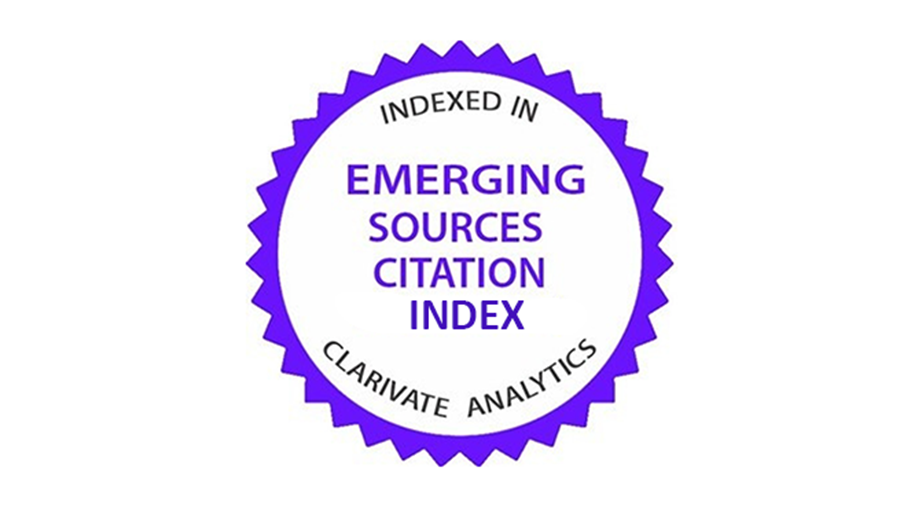The Impacts of Climate-Induced Agricultural Drought on Four Cereal Crops: A Case Study in Bako Tibe District, Oromia National Regional State, Ethiopia
Abstract
Increasing temperature and altered precipitation patterns lead to the extreme weather events such as drought and flood, which severely affects the agricultural production. This study was aimed to assess the impact of climate change-induced agricultural drought on four cereal crops in Bako Tibe District. Time-series climate and crop yield data, recorded from 1989 to 2018, were acquired from NASA’s data portal and Bako Research Institute. The changes in temperature and precipitation were analyzed using Mann Kendall trend test. The agricultural drought index was analyzed using R-software. The correlation between the selected yield crops and drought indices were evaluated using Pearson correlation coefficient. The results show that trends of seasonal and annual maximum and minimum temperatures were significantly increased (P<0.05). However, seasonal and annual precipitations were insignificantly decreased (P>0.05). Moderate to severe agricultural drought intensities happened four times in the last three decades. These drought spells spatially covered about 36% of the total area of the district. Crop yields and drought indices were significantly correlated at p-values; 0.0034, 0.043, 0.003 and 0.001 for teff, wheat, barley and maize, respectively. The coefficient of determination (R2) values of crop yields were 28.3%, 30.9%, 28.5% and 34.6% for teff, wheat, barley and maize, correspondingly. The study clearly suggests that the increase in temperature and decrease in precipitation enhanced the frequency and intensity of drought events and these impacted the selected crop yields during the past three decades. The map-based results could be used as guides for governmental and non-governmental organizations concerning on drought impact mitigation activities in the district by encouraging farmers to adopt appropriate agricultural technologies, drought tolerant crop varieties and small scale irrigation.
Keywords
Full Text:
PDFReferences
Asfaw, A., Simane, B., Bantider, A., & Hassen, A. (2018). Determinants in the Adoption of Climate Change Adaptation Strategies: Evidence from Rainfed-Dependent Smallholder Farmers in North-Central Ethiopia (Woleka Sub-Basin). Environment, Development and Sustainability, 21, 2535-2565. Crossref
Beguería, S., Vicente‐Serrano, S. M., Reig, F., & Latorre, B. (2014), Standardized Precipitation Evapotranspiration Index (SPEI) Revisited: Parameter Fitting, Evapotranspiration Models, Tools, Datasets and Drought Monitoring. The International Journal of Climatology, 34(10), 3001-3023. Crossref
Black, R., Adger, W. N., Arnell, N. W., Dercon, S., Geddes, A., & Thomas, D. (2011). The Effect of Environmental Change on Human Migration. Global Environmental Change, 21(Supplement 1), S3-S11. Crossref
Brown, M. E., Funk, C., Pedreros, D., Korecha, D., Lemma, M., Rowland, J., Williams E., & Verdin, J. (2017). A Climate Trend Analysis of Ethiopia: Examining Subseasonal Climate Impacts on Crops and Pasture Conditions. Climatic Change, 142(1-2), 169-82. Crossref
Calanca, P. (2007). Climate Change and Drought Occurrence in the Alpine Region: How Severe Are Becoming the Extremes?. Global and Planetary Change, 57(1-2), 151-60. Crossref
Deressa, T. T., Hassan, R. M., & Ringler, C. (2011). Perception of and Adaptation to Climate Change by Farmers in the Nile Basin of Ethiopia. Journal of Agricultural Science, 149(1), 23-31. Crossref
Diffenbaugh, N. S., Pal, J. S., Giorgi, F., & Gao, X. (2007). Heat Stress Intensification in the Mediterranean Climate Change Hotspot. Geophysical Research Letters, 34(11), L11706. Crossref
Edwards, D. C. (1997). Characteristics of the 20th Century Drought in the USA at Multiple Time Scales. Climatology Report 97-2, Department of Atmospheric Science, Colorado State University, Fort Collins.. Retrieved from Link
Egal, F. (2019). Review of The State of Food Security and Nutrition in the World, 2019 Safeguarding Against Economic Slowdowns and Downturns. World Nutrition, 10(3), 95-97. Crossref
EPA, (2011). The Federal Democratic Republic of Ethiopia Environmental Protection Authority. GEF Portfolio Identification Document, Addis Ababa, Ethiopia. Retrieved from Link
Feenstra, J. F., Burton, I., Smith, J. B., & Tol, R. S. J. (1998). Handbook on Methods for Climate Change Impact Assessment and Adaptation Strategies. United Nations Environment Programme (UNEP) and vrije Universiteit amsterdam Institute for Environmental Studies, 1-464. Retrieved from Link
Funk, C., Harrison, L., Shukla, S., Pomposi, C., Galu, G., Korecha, D., Husak, G., Magadzire, T., Davenport, F., Hillbruner, C., Eilerts, G., Zaitchik, B., &Verdin, J. (2018). Examining the Role of Unusually Warm Indo-Pacific Sea-Surface Temperatures in Recent African Droughts. Quarterly Journal of the Royal Meteorological Society, 144(51), 360-383. Crossref
Getachew, B. (2018). Trend Analysis of Temperature and Rainfall in South Gonder Zone, Anhara Ethiopia. Journal of Degraded and Mining Lands Management, 5(2), 1111-1125. Crossref
Gingrich, P. (2004). Chapter 11 Association Between Variables. Introductory Statistics for the Social Sciences. University of Regina. Retrieved from Link
Hamed, K. H., & Rao, A. R. (1998). A Modified Mann-Kendall Trend Test for Autocorrelated Data. Journal of Hydrology, 204(1-4), 182-96. Crossref
Hargreaves, G. H., & Allen, R. G. (2003). History and Evaluation of Hargreaves Evapotrans-piration Equation. Journal of Irrigation and Drainage Engineering, 129(1), 53-63. Crossref
Hatfield, J. L., & Prueger, J. H. (2015). Temperature Extremes: Effect on Plant Growth and Development. Weather and Climate Extremes, 10, 4-10. Crossref
Hendrix, C. S., & Salehyan, I. (2012). Climate Change, Rainfall, and Social Conflict in Africa. Journal of Peace Research, 49(1), 35-50. Crossref
Hicke, J. A., & Zeppel, M. J. B. (2013). Climate‐driven Tree Mortality: Insights from the Piñon Pine Die‐off in the United States. New Phytologist, 200(2), 301-303. Crossref
Intergovernmental Panel on Climate Change, [IPCC]. (2014). Climate Change 2013 – The Physical Science Basis: Working Group I Contribution to the Fifth Assessment Report of the Intergovernmental Panel on Climate Change. Cambridge: Cambridge University Press. Crossref
Kenawy, A. E., López-Moreno, J. I., & Vicente-Serrano, S. M. (2012). Trend and Variability of Surface Air Temperature in Northeastern Spain (1920-2006): Linkage to Atmospheric Circulation. Atmospheric Research, 106, 159-180. Crossref
Kindu, M., Schneider, T., Teketay, D., & Knoke, T. (2016). Changes of Ecosystem Service Values in Response to Land Use/Land Cover Dynamics in Munessa-Shashemene Landscape of the Ethiopian Highlands. Science of the Total Environment, 547, 137-147. Crossref
Lamaoui, M., Jemo, M., Datla, R., & Bekkaoui, F. (2018). Heat and Drought Stresses in Crops and Approaches for Their Mitigation. Frontiers in Chemistry, 6, 26. Crossref
Larson, L. L., & Larson, S. L. (1996). Riparian Shade and Stream Temperature : A Perspective. RANGELANDS, 18(4), 149-52. Retrieved from Link
Li, Z., He, Y., Wang, C., Wang, X., Xin, H., Zhang, W., & Cao, W. (2011). Spatial and Temporal Trends of Temperature and Precipitation during 1960-2008 at the Hengduan Mountains, China. Quaternary International, 236(1-2), 127-42. Crossref
Liu, W., Sun, F., Lim, W. H., Zhang, J., Wang, H., Shiogama, H., & Zhang, Y. (2018). Global Drought and Severe Drought-Affected Populations in 1.5 and 2 °C Warmer Worlds. Earth System Dynamics, 9(1), 267-83. Crossref
Makombe, G., Namara, R. E., Awulachew, S. B., Hagos, F., Ayana, M., & Kanjere, M. (2017). An Analysis of the Productivity and Technical Efficiency of Smallholder Irrigation in Ethiopia. Water SA, 43(1), 48-57. Crossref
Mera, G. A. (2018). Drought and Its Impacts in Ethiopia. Weather and Climate Extremes, 22, 24-35. Crossref
Meze-Hausken, E. (2004). Contrasting Climate Variability and Meteorological Drought with Perceived Drought and Climate Change in Northern Ethiopia. Climate Research, 27(1), 19-31. Crossref
Mondal, A., Kundu, S., & Mukhopadhyay, A. (2012). Rainfall Trend Analysis by Mann-Kendall Test: A Case Study of North-Eastern Part of Cuttack District, Orissa. International Journal of Geology, Earth and Environmental Sciences, 2(1), 70-78. Retrieved from Link
Rang, Z. W., Jagadish, S. V. K., Zhou, Q. M., Craufurd, P. Q., & Heuer, S. (2011). Effect of High Temperature and Water Stress on Pollen Germination and Spikelet Fertility in Rice. Environmental and Experimental Botany, 70(1), 58-65. Crossref
Rebetez, M., Dupont, O., & Giroud, M. (2009). An Analysis of the July 2006 Heatwave Extent in Europe Compared to the Record Year of 2003. Theoretical and Applied Climatology, 95, 1-7. Crossref
Sheffield, J., & Wood, E. F. (2008). Projected Changes in Drought Occurrence under Future Global Warming from Multi-Model, Multi-Scenario, IPCC AR4 Simulations. Climate Dynamics, 31, 79-105. Crossref
Shrestha, K. L. (1971). Anomalous Ionospheric Absorption and Microbarometric Activity at Ground Level. Journal of Atmospheric and Terrestrial Physics, 33(2), 213-19. Crossref
Smith, M. D. (2011). The Ecological Role of Climate Extremes: Current Understanding and Future Prospects. Journal of Ecology, 99(3), 651-655. Crossref
Suryabhagavan, K. V. (2017). GIS-Based Climate Variability and Drought Characterization in Ethiopia over Three Decades. Weather and Climate Extremes, 15, 11-23. Crossref
USAID. (2015). El Niño in Ethiopia: Uncertainities, Impacts and Decision-Making. Agriculture Knowledge, Learning Documen-tation and Policy (AKLDP) Project, 1-4. Retrieved from Link
Vicente-Serrano, S. M., Beguería, S., & López-Moreno, J. I. (2010). A Multiscalar Drought Index Sensitive to Global Warming: The Standardized Precipitation Evapotranspiration Index. Journal of Climate, 23, 1696-1718. Crossref
World Meteorological Organization, [WMO] & Global Water Partnership, [GWP]. (2016). Handbook of Drought Indicators and Indices (M. Svoboda and B.A. Fuchs). Integrated Drought Management Programme (IDMP), Integrated Drought Management Tools and Guidelines Series 2. Geneva. Retrieved from Link
Refbacks
- There are currently no refbacks.











